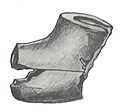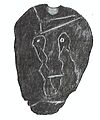Fifield Site facts for kids
Quick facts for kids Fifield Site |
|
|---|---|
| Lua error in Module:Location_map at line 420: attempt to index field 'wikibase' (a nil value). | |
| Location | on Damon Run Creek near Babcock, Indiana |
| Area | 4 acres (1.6 ha) |
The Fifield site (also known as Pr-55) is an important archaeological spot. It is located on Damon Run Creek in Porter County, Indiana, in the northwestern part of Indiana. This site is from a time called the late Prehistoric period. It was a village of the Upper Mississippian people, specifically the Fisher group.
Contents
Digging Up the Past: Archaeological Investigations
Archaeologists are like detectives who study the past. They dig up old sites to learn about people who lived long ago.
Early Discoveries
The first big digs at the Fifield site happened in 1949. A person named Robert Skinner led these first explorations.
More Digging and Studying
From 1950 to 1959, Robert Reichert continued the excavations. He found many interesting things. Later, in 1972, Charles Faulkner carefully studied all the items found. He then shared his findings in a published report.
What We Found: Results of the Analysis
The excavations at Fifield uncovered many clues about the people who lived there. These clues included ancient pits, tools, animal bones, and plant remains.
Ancient Pits and Structures
About 45 pits were found during the digs. Most of these were basin-shaped. They were likely used for storing food or for trash. Eight pits showed signs of fire at the bottom. These were probably used for roasting food.
Archaeologists also found many "post molds." These are marks left in the ground where wooden posts once stood. While no complete house shapes were clear, the patterns of these post molds suggested that the buildings had rounded walls.
Animal Bones: What They Ate
Around 2,713 animal bones were found at the site. The most common animals were deer, dog, elk, beaver, raccoon, bear, bison, and turkey. These bones were not made into tools. This means they were likely leftovers from meals. They tell us a lot about what the people hunted and ate.
Tools and Treasures: Artifacts
Many different artifacts were found at the Fifield site. These items help us understand the daily lives and beliefs of the people.
- Pottery: Over 2,400 pieces of pottery were found. No whole pots were discovered. So, researchers studied the rim pieces and special body pieces to learn about the pottery styles.
- Stone Tools: There were 262 chipped stone tools. This included 215 projectile points (like arrowheads), 16 knives, 22 scrapers, and 25 drills.
- Ground Stone Tools: Nine ground stone tools were found. These included tools for straightening arrow shafts, axes (celts), a piece of a pipe, and a piece of red rock (hematite) used for paint.
- Bone and Antler Tools: Sixty-one tools were made from bone and antler. These included fishhooks, antler arrow points, a harpoon, hoes made from bison shoulder blades, deer bone tools for working hides, bird bone needles, awls (for piercing), a beaver tooth chisel, and even musical instruments like a rasp and a whistle.
- Copper Items: Two rare copper artifacts were found. One was a copper pendant. The other was a unique copper serpent figurine.
- Special Pendants: One pendant made from a broken pottery piece had a "weeping eye" design.
- Stone Pipe: A fragment of a stone pipe was also found.
- Pottery Disc: One circular disc made from a pottery piece was discovered. Its use is unknown.
A Special Discovery: The Tool Cache
During Reichert's excavations, a special collection of tools was found. These tools were made from bone and antler. They were covered by a layer of red powder called red ochre.
The tools in this collection included:
- Four deer bone tools for working animal hides.
- A bone scraper made from elk or bison bone.
- An unmodified piece of bone, possibly raw material for a tool.
- Four needles made from bird bones.
- An antler harpoon.
These tools were likely used for everyday tasks. This included preparing animal hides, sewing mats, and making clothes. The red ochre suggests this collection might have had a ceremonial meaning. Red ochre was often used in special ceremonies by early Native American groups.
Important Artifacts from Fifield
Here are some of the most interesting tools and items found at the site:
- Small Triangular Points: These are also called "arrowheads." They were likely used as tips for bows and arrows. The use of bows and arrows became much more common around 1000 AD. This was probably because there was more conflict between groups.
- Biface Knives: These stone knives were used for cutting. They are often found at Upper Mississippian sites.
- Humpback End Scrapers: These tools were used for working wood or animal hides. They are also common at Upper Mississippian sites.
- Drills: Two types of drills were found. They were used for working wood or hides.
- Arrowshaft Straighteners: These stone tools helped make arrow shafts straight for bows and arrows.
- Antler Projectile Points: These arrow points were made from antler. Some were barbed, and others were socketed.
- Antler Harpoon: This tool was used for fishing.
- Deer Cannon Bone Beamers: These bone tools were used to prepare animal hides.
- Bison Scapula Hoes: These hoes, made from bison shoulder blades, were used for farming or digging. They might have been used to dig the storage pits at Fifield.
- Bird Bone Needles: These small needles were used for sewing mats or clothing.
- Antler Comb or Hairpin: This item might have been used for personal decoration or in ceremonies.
- Antler Cylinders / Game Pieces: These small antler pieces were likely used in gambling games. Gambling was a popular activity among early Native American tribes.
- Equal-Arm Type Pipe Fragment: This piece of a stone pipe was used for smoking. It might have been part of a ceremony or for recreation.
- Copper Pendant: This copper ornament was likely for personal decoration or ceremonies.
- Copper Serpent: This rare copper figurine might have been an art piece or had religious meaning. Similar serpent figures have been found at other sites in the American Midwest.
- Sherd Pendant with "Weeping Eye" Motif: This pendant, made from a piece of pottery, has a special "weeping eye" design. This design is often seen on items from the late Prehistoric to early Historic periods. It shows that someone at Fifield copied this design onto a pottery piece.
- Circular Sherd Disc: This disc made from pottery has an unknown purpose. It is a common item in late Prehistoric Oneota culture.
Pottery Styles: Fisher Ware
Around 1000 AD, cultures in the Great Lakes region started to be influenced by the powerful Mississippian groups from the Mississippi River Valley. Archaeologists call these influenced local cultures "Upper Mississippians." The Fisher culture, found at Fifield, is one of these groups. It is closely related to another Upper Mississippian group called Oneota.
What is Fisher Ware?
Fisher ware pottery was first identified at the Fisher Mound site in Illinois. It has also been found at other sites in Illinois and Indiana.
This pottery has special features:
- It uses crushed shell mixed into the clay (called tempering).
- Most surfaces have marks from cords (called cordmarked).
- It often has designs made by trailing or incising lines.
- The rims are usually straight, curved outwards, or flared.
- Notched lips and rim lugs (small handles) are also common.
Types of Fisher Ware at Fifield
Three specific types of Fisher ware were found at the Fifield site:
- Fifield Trailed: This pottery has fine to medium lines that are close together. These lines can be horizontal, vertical, or form nested chevron patterns. Small dots (punctates) are also sometimes present. The lips are often notched or crimped. Some pots have lugs or handles.
- Fifield Bold: This is similar to Fifield Trailed, but the lines are wider. They might have been made with a finger instead of a tool.
- Fisher Cordmarked: Only one vessel of this type was found. It had a plain cordmarked surface without any other decoration. This is rare for Fisher pottery.
Other Pottery Finds
Small, miniature pots were also found at Fifield. These are common at other sites in the area. They might have been "toy" pots for children or practice pieces for young potters.
Some pieces of Langford Ware were also present. This pottery comes from another Upper Mississippian culture in Illinois. These pieces were made with grit (small stones) mixed into the clay. They were likely traded to the people at Fifield.
Why the Fifield Site is Important
The Fifield site is very important because it is a "single-component" site. This means it was mainly used by one group of people: the Upper Mississippian Fisher group.
The pottery styles and special artifacts, like the copper serpent, the sherd disc, and the "weeping eye" pendant, tell us something important. They show that the site was used almost up to the time when Europeans first arrived in North America.
Based on the animal bones, plant remains, and the many storage pits, archaeologists believe the site was occupied during the fall and winter. It was likely a semi-permanent farming village. While no corn (maize) was found, the early excavators did not specifically look for plant remains.
Images for kids









